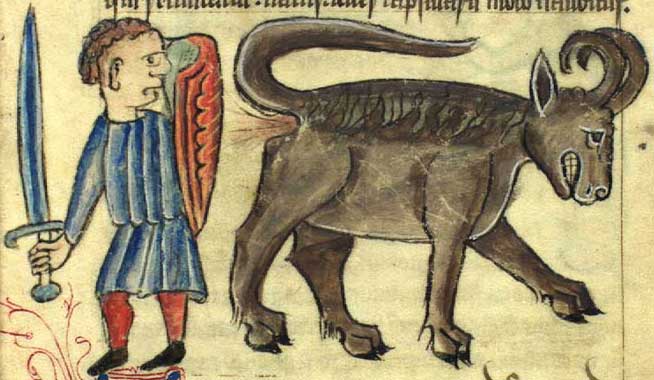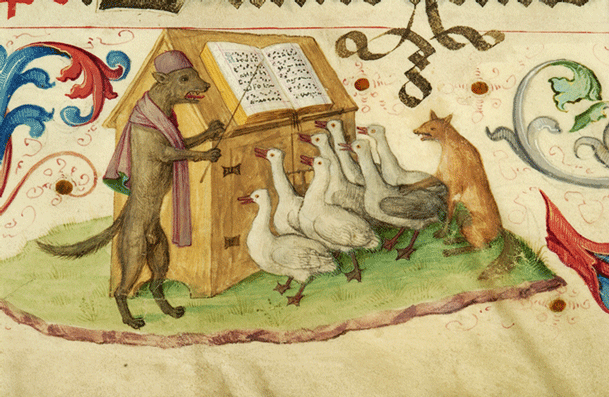Studying Medieval Animals: The Case Of The Panther
Using numerous images and literary references, this lecture will work towards constructing a cultural history of the medieval panther which takes account of both traditional and contemporary scholarly approaches.
The Vikings and the animals that came with them to Britain
When the Viking Great Army invaded England in 865, it was not just people who arrived. A new study of cremated bone fragments from burial mounds reveals that horses, dogs and other animals also made the North Sea crossing.
Madagascar’s human expansion 1,000 years ago linked to loss of large animals
A human genetic study links the first major expansion of humans on the island with the loss of large vertebrates.
Medieval Storytime: Animals
For this week’s medieval storytime, Danièle reads a collection of descriptions, fables, and poems all featuring animals. From venomous toads to proud peacocks and malicious whales, the Middle Ages shares its moral worldview through the animal kingdom.
(Medieval) Fantastic Beasts and Where to Find Them: Imagining Animals in the Middle Ages
The wild landscape in the medieval imagination is both enchanting and enchanted.
Criminalising Animals in Medieval France: Insights from Records of Executions
This article explores compelling and specific cases from France during the fourteenth and fifteenth centuries in which animals were formally executed for crimes.
Wild animals and medieval towns
In the year 1166, the town of Carmarthen in southern Wales was attacked by a rabid wolf, which bit 22 people.
Animals came with medieval trade in Indian Ocean, researchers find
The earliest introduction of domestic chickens and black rats from Asia to the east coast of Africa came via maritime routes between the 7th and 8th centuries AD.
The Law is an Ass: Reading E.P. Evans’ The Medieval Prosecution and Capital Punishment of Animals
In this essay I address a little-known chapter in the lengthy history of crimes against (nonhuman) animals. My focus is not crimes committed by humans against animals, as such, but a practical outcome of the seemingly bizarre belief that animals are capable of committing crimes against humans
The Medieval Magazine: Animals in the Middle Ages (Issue 41)
From Parrots to Whales, this week we take a look at medieval wildlife. You can also read about medieval treasures in Madrid, Bells in England, a mad King in Norway, and a few fascinating archaeological discoveries.
Ten Strange Medieval Animals You Might Not Have Heard Of
A fish that can stop a ship and a bull that passes gas to defend itself – these and more strange animals from the Middle Ages!
The Sounds that Animals Make – the Medieval Version
It seems that every parent at one time or another teaches their children the sounds that animals make. They did it in the Middle Ages too.
Animals in the Middle Ages: The Monkey
‘Monkeys are animals that like to imitate everything they see men doing. They feel happy when there is new moon, and with the full and waning moon, they get sad and filled with melancholy.’
Ten Strange Medieval Ideas about Animals
Vipers killing each, panthers and their sweet breath, and how deer cure themselves of illness – the medieval bestiary and strange ideas about animals.
Animals in Saxon and Scandinavian England
In this book an analysis of over 300 animal bone assemblages from English Saxon and Scandinavian sites is presented. The data set is summarised in extensive tables for use as comparanda for future archaeozoological studies.
The use of animals in medicine of Latin tradition: Study of the Tresor de Beutat, a medieval treatise devoted to female cosmetics
The Tresor de Beutat is a medieval treatise written in the 14th century. It contains a set of medical and cosmetic recipes aimed exclusively at women.
Animals in the Middle Ages: The Elephant
Here are ten interesting notes about medieval elephants
Like a Duck to Water: Representations of Aquatic Animals in Early Anglo-Saxon Literature and Art
In the second book of his Life of Columba abbot Adomnan of Iona relates some details regarding the second and third voyages of the monk Cormac in search of ‘a desert place in the ocean’.
Do Animals Go to Heaven? Medieval Philosophers Contemplate Heavenly Human Exceptionalism
Beginning in about the second century C.E., Christian philosophers reflected upon the nature of human beings, our purpose on earth, and our path to the promised afterlife. In the course of these reflections, they considered our relationship to nature, and the non- human animals that share our world.
Call for Papers: (Un) Expected Animals in (Un)Expected Places in the Middle Ages and Early Modern Period
Conference taking place on May, 6-7 2014, at the University of Louisville, Kentucky
Animals on Trial
The history of animals in the legal system sketched by Evans is rich and resonant; it provokes profound questions about the evolution of jurisprudential procedure, social and religious organization and notions of culpability and punishment, and funda-mental philosophical questions regarding the place of man within the natural order.
Animals in Medieval Sports, Entertainment, and Menageries
We shall see that apes, marmosets, and popinjays were hardly the only kinds of animals pressed into service as entertainers for medieval people, for virtually every common European animal – and a large number of exotic imported species as well – took some part, large or small, in games, spectacles, menageries, performances, tournaments, and displays.
Human Drama, Animal Trials: What the Medieval Animal Trials can Teach Us About Justice for Animals
There is a long history, mainly from the medieval and early modern periods, of animals being tried for offenses such as attacking human beings and eating crops.
Looking at animals in human history
Taking in a wide range of visual and textual materials, Linda Kalof unearths many surprising and revealing examples of our depictions of animals.
The Law is an Ass: Reading E.P. Evans’ The Medieval Prosecution and Capital Punishment of Animals
In this essay I address a little-known chapter in the lengthy history of crimes against (nonhuman) animals. My focus is not crimes committed by humans against animals, as such, but a practical outcome of the seemingly bizarre belief that animals are capable of committing crimes against humans.





















